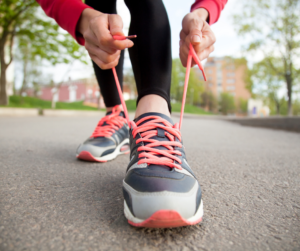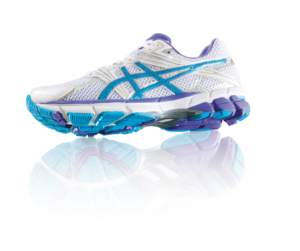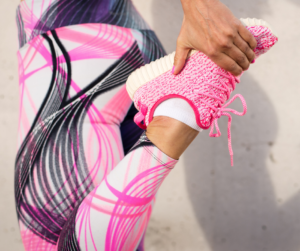
 If you’ve ever felt overwhelmed by the vast selection of joggers available at a shoe store – you’re not alone. While many people know that not every shoe is right for them, lots have trouble understanding which ones are right for them – and why.
If you’ve ever felt overwhelmed by the vast selection of joggers available at a shoe store – you’re not alone. While many people know that not every shoe is right for them, lots have trouble understanding which ones are right for them – and why.
Today, the My FootDr team guide you through what you need to know to help you choose the best running shoe that your feet will love!
1. Get The Lingo
There are many terms used by shoe manufacturers and sales staff that can be quite confusing to the average person. Understanding these is very helpful when it comes to choosing shoes, as it allows you to make informed choices and be confident with your purchase. From pronation to shoe shank and much more, check out our list of running shoe lingo here.
2. Start With Well-Known Stores Or Brands
 Despite the price tags, there’s a good reason that specific brands and stores are worth the investment. At specialist running footwear stores like Athlete’s Foot, the staff undergo extensive training in everything from shoe features to fitting – and even examining your gait on the treadmill. This means you can ask questions, get professionally fitted, and feel confident that your shoes are likely to be promoting you staying active and healthy – instead of placing you at risk of injury. It’s why we sell shoes at selected clinics too!
Despite the price tags, there’s a good reason that specific brands and stores are worth the investment. At specialist running footwear stores like Athlete’s Foot, the staff undergo extensive training in everything from shoe features to fitting – and even examining your gait on the treadmill. This means you can ask questions, get professionally fitted, and feel confident that your shoes are likely to be promoting you staying active and healthy – instead of placing you at risk of injury. It’s why we sell shoes at selected clinics too!
The benefit of well-known brands like Asics and New Balance is that their shoes undergo extensive testing and research. These manufacturers adapt quickly to new materials and technology, and they have a broad range of styles, widths and support levels, meaning you’ll almost certainly find the right shoe for your feet.
3. Understand your foot type
It’s one thing to know if you have a pronated, supinated or neutral foot type, and it’s another to understand what it means when it comes to buying running shoes.
- A pronated foot type is one that ranges from flatter than normal to completely flat. This foot type usually benefits most from a shoe with a matching level of arch support.
- A supinated foot type is high arched, often lacking some of the natural shock absorption and ability to adapt to uneven ground that comes with a healthy level of pronation. This foot type often benefits from a neutral shoe with a good level of cushioning and added stability. Be careful – pairing this foot type with a shoe designed for pronation may encourage the foot to roll outwards, causing an ankle sprain.
- A neutral foot type is one that has a small and healthy amount of both pronation and supination during gait, often exhibiting an arch that isn’t too big or small. This foot is also often suited to a neutral shoe, though depending on the level of pronation during gait, may also use a shoe with mild pronation control.
4. Consider Your Activity And Weight
Are you going to be pounding the pavement five times per week? Will your weight be putting more pressure on your shoes? If this is the case, you may need shoes with materials that are more durable and better able to handle high impact forces, so they don’t wear down quickly. If your shoes are primarily for short sprints and shorter workouts, you may opt for lighter shoes that are secured snuggly to your feet. If you’re a trail runner, you will need more grip and durability on your soles. Ask about the durability, weight and the function of the materials in the shoe – and make sure it matches with your activities.
5. Get Measured Every Time
 Your feet can change over time for many reasons. For example, your arch may naturally flatten as you age, pregnancy hormones may relax your ligaments leading to wider and bigger feet, and clawing of the toes may lead to your foot size appearing smaller. Always have your feet measured with every new pair of shoes – especially if you’re changing brands as sizes may slightly vary between different brands too. Don’t forget:
Your feet can change over time for many reasons. For example, your arch may naturally flatten as you age, pregnancy hormones may relax your ligaments leading to wider and bigger feet, and clawing of the toes may lead to your foot size appearing smaller. Always have your feet measured with every new pair of shoes – especially if you’re changing brands as sizes may slightly vary between different brands too. Don’t forget:
- Make sure you’re measuring to your longest toe, which isn’t necessarily your big toe!
- Most people have one longer foot, so make sure both feet feel comfortable in the shoes
- Take the insert out of the shoe and stand on it
- If you have orthotics, put them in the shoe and test for size and fit
6. Width Matters – And So Do Socks!
There’s so much focus on the right length that people often forget that good running shoes often come in different widths, as well as different sizes. Stay mindful of the width when you’re trying it on and if you feel any rubbing on the sides of your feet – go up a width. This isn’t one of the things you want to rely on ‘wearing in’. Don’t forget to consider the width of your socks too – if you usually wear thicker running socks, don’t bring thin ankle socks to your fitting!
7. Always Bring Your Orthotics
Once your orthotics are placed inside your shoes, they function as a unit with the goal of doing the best by your feet. You want to make sure that your orthotics fit the new shoes well, that there’s enough space once the orthotic is in to fit your foot comfortably, and that the orthotic still feels right when it comes to doing the job that it was created for.
If you have any issues with the fit – like if the end of the orthotic is a fraction too long, we can also help reduce it to the right size. Bring your shoes along to your next appointment at My FootDr and we’ll adjust your orthotics in the clinic. Make sure not to wear your new shoes without orthotics if you’ve been instructed to wear your orthotics constantly.
8. No Compromising On Comfort
Just like pain is our body’s way of letting us know that something is wrong, comfort and stability let us know that it’s right! Never compromise on comfort, or leave thinking “it’s okay, I’ll wear it in”. Make sure you walk around the store in both shoes – and we recommend having a run on the in-store treadmill too!
Lacing often affects fit and can help solve discomfort at the top of the foot, so don’t be afraid to play around with multiple lacing styles while you’re assessing your comfort. Many stores also have a money-back guarantee if your shoes aren’t working for you in the first 14-28 days, so don’t forget to take advantage of that if you need to.
Need Help From The Professionals?
If you’re still unsure about choosing the best running shoes for your feet and want the confidence and assurance from the foot health professionals, we’d love to help! We’ll assess your feet, your gait, your symptoms (if any) and can make specific recommendations on the best shoes for your feet. We even have shoes available in-store at selected clinics!
Click here to book your appointment
Get in quick to claim our '$95 Comprehensive Initial Consult' offer online here!


